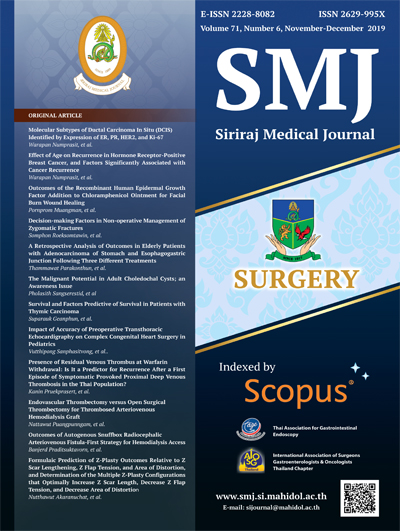Decision-making Factors in Non-operative Management of Zygomatic Fractures
DOI:
https://doi.org/10.33192/Smj.2019.67Keywords:
Zygomatic fracture; factors; non-operative treatmentAbstract
Objective: A zygomatic fracture is one of the most common fractures of the maxillofacial bone. The treatment of zygomatic fractures can be performed either by surgical or non-surgical management. However, few studies have evaluated the reasons for choosing non-surgical treatment.
Methods: A retrospective observational study was performed of patients with zygomatic fractures that presented in Siriraj Hospital, Thailand, from January 1, 2010, to December 31, 2014. The factors associated with the non-operative treatment of zygomatic fractures were evaluated. Moreover, we analyzed the patient data, such as their age, etiology, type of fracture, complications, associated facial fractures, and associated other organ injuries.
Results: There were 337 patients with a zygomatic fracture during this period. Most of the cases involved males. Traffic accidents represented a common cause of the fracture. The mean patient age was 36 years old. Trimalar fracture of the zygoma was the most common type of fracture. The most common complication with zygoma fractures was infraorbital nerve injury. Of the study population, 161 patients (47.8%) received non-operative treatment and 176 patients (52.2%) received operative treatment. Older age (adjusted odds ratio (95% CI); 1.02 (1.00-1.03), p-value = 0.049), no diplopia (adjusted odds ratio (95% CI); 12.30 (3.28-46.14), p-value < 0.001), no infraorbital nerve injury (adjusted odds ratio (95% CI); 6.76 (3.81-11.99), p-value < 0.001), and no cosmetic concern (95% CI); 92.82 (11.97-719.44), p-value < 0.001) were the only four factors related to non-operative management decisions.
Conclusion: Older age, no diplopia, no infraorbital nerve injury, and no cosmetic concern of the patient were the factors associated with the non-operative treatment of zygomatic fractures.
Downloads
Published
How to Cite
Issue
Section
License
Authors who publish with this journal agree to the following conditions:
Copyright Transfer
In submitting a manuscript, the authors acknowledge that the work will become the copyrighted property of Siriraj Medical Journal upon publication.
License
Articles are licensed under a Creative Commons Attribution-NonCommercial-NoDerivatives 4.0 International License (CC BY-NC-ND 4.0). This license allows for the sharing of the work for non-commercial purposes with proper attribution to the authors and the journal. However, it does not permit modifications or the creation of derivative works.
Sharing and Access
Authors are encouraged to share their article on their personal or institutional websites and through other non-commercial platforms. Doing so can increase readership and citations.















